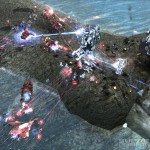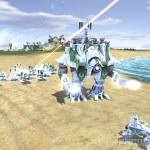The real time strategy genre is going through something of resurgence recently. PC gamers are spoilt for choice with the genre lending itself so readily to the keyboard and mouse as a method of input. Console gamers, on the other hand, have been witness to a procession of increasingly-imaginative ways that developers have tried to take the massive control capabilities of a mouse and distil them down into a couple of analogue sticks and a limited number of buttons.
Supreme Commander 2 does the best job so far at making the traditional RTS controls work and moulding the gameplay so that things like multiple squad groups are not missed. In Supreme Commander 2 we have a streamlined system of control using radial wheels, double-taps and D-Pad shortcuts. The control scheme is pared down to the essentials but that is a philosophy which is closely mirrored in the maps and play-style.
The battlefields in Supreme Commander 2 are not huge but there is a bit of room and often multiple routes and choke-points to defend. Like everything else in this game, the map design strives to find a balance between the expansive areas, which will give the player plenty of options, and the realistic scale which keeps everything manageable. The balance is struck perfectly with very few times when you feel restricted by limited space and even fewer when you have so much space that you lose units.
One of the ways that the RTS genre has evolved over the years has been the inclusion of “Hero Units” which are basically single units with special abilities and status amongst your armies. Console RTS have often taken this idea to an extreme in an effort to keep the number of required units down but Supreme Commander 2 doesn’t force the issue here either. You have the commander-housing walker which acts as the chief base-builder (the range of structures are limited but healthy enough) and mobile command unit and you can develop and build a number of experimental units which have greater firepower or defensive capabilities but other than that (and the gradual upgrade-through-experience that normal units benefit from) everything is standard.
So, in terms of control and mechanics, Supreme Commander 2 successfully walks that fine line of compromise without ever feeling like it short-changes us. The same is true for the technical aspects of the game. Graphically it is decent but not exceptional, although with map size and the number of units in play that is forgivable. The sound is also fairly standard and the incidental music won’t trouble Mozart’s estate. The general feeling from everything in Supreme Commander 2 so far is that the game is good but never really excels in any one area. Even the storyline and voice-acting is standard action-game fare with the usual mix of evildoers, conscientious heroes and an undercurrent of tested loyalties.
All of this leaves us with one important question: How does the game play?
Happily, it is a pleasure to play through. The carefully-crafted controls quickly become natural and the mission-length is just about right – each one takes around half an hour to complete. You are awarded for speed and thoroughness without being too-harshly punished for the common laziness of amass-and-raid style of play. In short, you can delicately manage your combat tactically or you can hang back and rely on your defences while building a huge army with which to storm the enemy’s position. Again, Supreme Commander 2 balances itself between the hardcore and the casual RTS player.
There are three factions in the game, each with their own campaigns, and a skirmish mode alongside the usual cooperative and competitive multiplayer options (online only). Each mission can be replayed out of sequence once it has been unlocked by meeting it in the campaign mode. For each mission you are graded on a number of criteria and decorated accordingly so there is an incentive to return to the missions. In truth though, the campaigns are so well paced and engaging that you will probably lose some of the class of this title by playing things out of sequence.
The enemy AI is challenging at times but on the whole it does little more than guard or attack and is quite single-minded. This makes it relatively easy to out-think the enemy but there are times when you simply won’t have the resources to fight in the traditional way. The narrow walkways and well-positioned resource-points give you the ability to hone your tactics and the costly experimental units are often a false economy. Providing a lot of firepower for a high price but leaving it all in one place may not always be the most sensible option.
Supreme Commander 2 does an excellent job at refining the RTS genre into a very console-friendly format without feeling overly restrictive. It probably won’t appeal to the hardcore strategists that have been playing this style of game for years (or on a PC) but it most definitely should appeal to anyone new to the genre who wants to experience it at its best on a home console.
Pros:
- Great map design and perfect size.
- Good pacing and engaging missions.
- Accomplished control scheme.
Cons:
- The technical aspect is not exceptional.
- Standard plot and storyline.
- AI could be a little more challenging at time.
Supreme Commander 2 will inevitably be compared to the Command & Conquer games or Halo Wars and it easily stands up to those comparisons. This is not a revolutionary step forward in console RTS but it is a steady improvement on what we’ve seen before and probably the most enjoyable console RTS yet.







